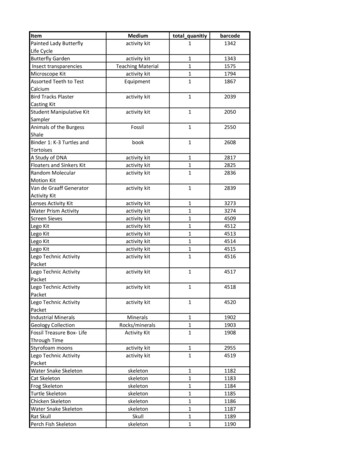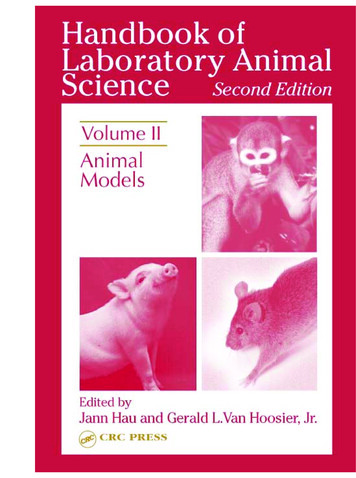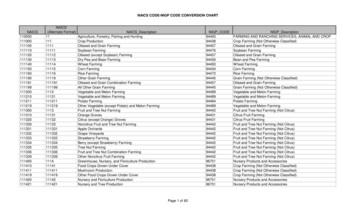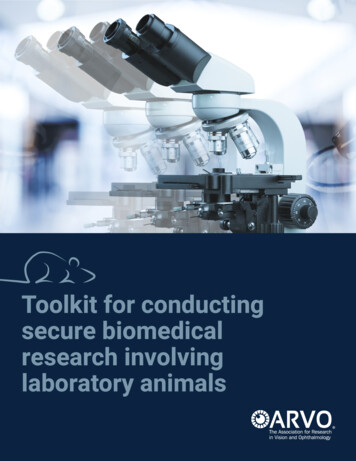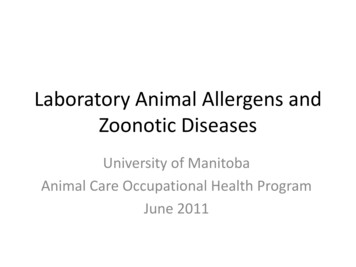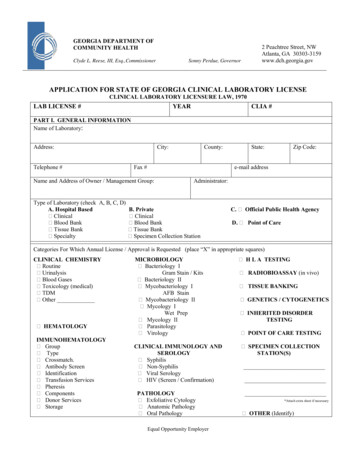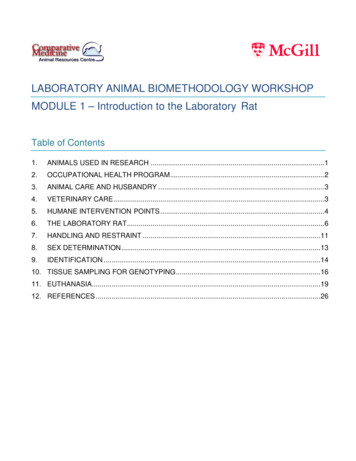
Transcription
LABORATORY ANIMAL BIOMETHODOLOGY WORKSHOPMODULE 1 – Introduction to the Laboratory RatTable of ContentsANIMALS USED IN RESEARCH .1OCCUPATIONAL HEALTH PROGRAM.2ANIMAL CARE AND HUSBANDRY .3VETERINARY CARE .3HUMANE INTERVENTION POINTS .4THE LABORATORY RAT .6HANDLING AND RESTRAINT .11SEX DETERMINATION .13IDENTIFICATION .14TISSUE SAMPLING FOR GENOTYPING .16EUTHANASIA.19REFERENCES .26
Rat Module 1 QuizComplete the quiz after reading this handout.You must score 20/25 to successfully complete the training.Score will be available immediately after completion.Review any incorrect answers once the quiz is graded.Module 1 Quiz
ANIMALS USED IN RESEARCHAt McGill University, the use of live animals is subject to scientific/pedagogical merit and ethical review to ensure thatlive animals are used only when necessary and with full commitment to the wellbeing of the animals. McGill Universityis dedicated to conducting the highest-quality research and to providing animals with the best care. The use of animalsin research, teaching and testing is a privilege governed by public concerns, federal and provincial laws and regulations,the Canadian Council on Animal Care (CCAC) guidelines and policies, and McGill University policies, procedures andguidelines.The CCAC is the national peer-review organization responsible for setting and maintaining standards for the ethicaluse and care of animals used in science throughout Canada. McGill’s Animal Care and Use Program is certified by theCCAC based on institutional compliance with CCAC standards. This certification is required to receive funding fromthe Canadian Institutes of Health Research (CIHR), the Natural Sciences and Engineering Research Council ofCanada (NSERC), or the Social Sciences and Humanities Research Council (SSHRC), as well as some provincialfunders and charitable organizations.McGill University’s Policy on the Study and Care of Animals outlines the basic principles for the care of animalsinvolved in research, teaching or testing at McGill University and affiliated institutions.The privilege of using animals can be withdrawn for individuals who, by their negligence or deliberate actions, establishnon-compliance with CCAC guidelines, McGill Policies and SOPs, and the approved animal use protocol. Theseindividuals might face additional disciplinary measures, including reporting the non-compliance to other instances.1.1. The Animal Use ProtocolAll procedures involving the use of animals in research, teaching and testing must be described in an Animal UseProtocol (AUP).All animal-based protocols must comply with CCAC and McGill University policies and guidelines. AUPs are peerreviewed for scientific or pedagogical merit and are approved by the local Facility Animal Care Committee (FACC)before animals are purchased and used.AUPs contain detailed information on: All procedures performed on live animals, including euthanasia methods. All substances being administered to live animals, including potentially hazardous agents. Animal housing and procedure locations. The total numbers of animals to be produced and used in a given year, including alternatives forreplacement and reduction of animal use. Anticipated signs of morbidity or adverse effects on the health and welfare of the animals andmonitoring frequency. Humane intervention points, which are clear criteria set to prevent or relieve unnecessary pain ordistress to a research animal. Strategies employed to implement the three Rs – replacement, reduction, and refinement. Personnel working with live animals.CMARC Rat Module 1 Handout Revised 2021.011
1.2. Standard Operating ProceduresMcGill University has created over 100 Standard Operating Procedures (SOPs) that provide guidelines for commonlyused procedures including analgesia, anesthesia, surgical and experimental procedures, euthanasia, etc.SOPs establish best practices and ensure adherence to all relevant regulations. They are created by the VeterinaryCare Subcommittee and routinely reviewed.SOPs are an invaluable resource for any individual working with laboratory animals and should be consultedregularly.1.3. Quality Assistance ProgramThe Quality Assistance Program (also known as Post-Approval Monitoring) ensures animal wellbeing, is a resource andassistance to the FACC and to the research community, and ensures adherence to approved procedures.Adherence to Animal Use Protocols is achieved by assessment visits and procedure observations. Assessment visitsare carried out by Quality Assistance Advisors.1.4. Education and TrainingAll individuals involved in the care and use of animals must receive appropriate training, both theoretical and practical,and adequate preparation before undertaking a procedure, using, or caring for a species. Having a good workingknowledge of the AUP is essential.Individuals using or caring for animals at McGill or its affiliated institutions have a responsibility for the properstewardship of animals under their care; this includes adhering to protocols, policies, procedures and guidelines.Furthermore, each participant in the Animal Care and Use Program is accountable for reporting animal welfare andcompliance concerns. The Guidelines for Animal Welfare and Compliance Concerns describes participants’responsibilities.Failure to adhere to McGill policies, procedures and guidelines may result in revocation of access to the animalfacility.In the spirit of promoting humane use of animals in training and applying the principles of the three Rs, animalsused in training are subject to a set of specific intervention points detailed in SOP 418 – Humane InterventionPoints for Animals Used in Training. The goal being to reduce the total number of animals used in training, reuseanimals in a humane and responsible manner, and refine the procedures to minimize discomfort and distress.OCCUPATIONAL HEALTH PROGRAMThe Occupational Health Program (OHP) for Animal Related Activities addresses the health risks that may resultfrom working with animals. Participation in the OHP is voluntary for personnel in contact with rodent species. However,individuals who are exposed to animals, tissues, body fluids, wastes, bedding, living quarters or equipment involved inthe care and use of animals are strongly encouraged to participate in the OHP.Allergies to animals are a common health issue in research and teaching animal facilities and are recognized as anoccupational hazard. Individuals with pre-existing allergic conditions face a greater risk of developing allergies.CMARC Rat Module 1 Handout Revised 2021.012
Wearing personal protective equipment (PPE) is one way to limit your exposure to rodent allergens.Always wear adequate attire (long pants, socks, and closed shoes) and PPE to enter areas where laboratory rodentsare handled or housed.Consult the Allergy Prevention factsheet for a list of symptoms and tips on preventing allergies.ANIMAL CARE AND HUSBANDRYIt is essential that all work involving live animals be performed in facilities that ensure the safety of the staff andstudents while maintaining the health and welfare of animals through high standards of animal care and facilitymanagement.Rodents are housed in facilities where the temperature, humidity, light cycle, and ventilation are continuouslymonitored and controlled. Husbandry of laboratory animals is the responsibility of the Animal Care team; they makesure animals have clean, comfortable cages, food and water and that the facilities are well maintained. Attendants alsoobserve cages on a daily basis and report any animal that appear ill or injured to the Veterinary Care team.Laboratory rodents are provided with environmental enrichment substrates or devices which allow foropportunities to express natural behavioural needs and promote physical and mental health. The presence ofenvironmental enrichment such as wood shavings and hiding tunnels, is essential for temperature regulation,social behaviour, reproduction, and the general wellbeing of the animals.Any deviations from the standard husbandry practices are detailed in the AUP and should be communicated tothe facility staff. Cages receiving special diet or water, being deprived of food or water for short periods, or havingdifferent husbandry requirements must be clearly labelled. Labelling should include the start and end date/timeand your contact information. Standard cage cards are available for common situations, refer to Annex 1.VETERINARY CAREThe Veterinary Care team is composed of animal health technicians and veterinarians; their role is to provide medicaland preventive care by evaluating clinical cases, providing treatment and monitoring animals. They also providetraining and technical services to the research community, make recommendations and share expertise, monitor theoverall health of the colonies, and work to improve the general welfare for animals used in research.Veterinarians have the authority and responsibility to make determinations concerning animal wellbeing and toassure that this is appropriately monitored and promoted.You can contact the Veterinary Care team with questions or concerns regarding animal health and wellbeing.The Veterinary Care team is also responsible for the management of the Veterinary Care Program. The programaims to detect and treat sick or injured animals thus preventing and relieving unnecessary pain and distress.You may come across a Veterinary Care cage card on one of your cages. This indicates that an illness/injury reporthas been submitted for one or more animals in that cage. Many of the cases tend to be common conditions such asaggression between animals, skin irritations, or eye infections. A member of the Veterinary Care staff will contact youif they find a more serious case that requires your attention.CMARC Rat Module 1 Handout Revised 2021.013
HUMANE INTERVENTION POINTSHumane intervention points are clear criteria set to prevent or relieve unnecessary pain or distress to a research animal.Intervention points should be balanced with the experimental endpoints to ensure that animals can be kept on study humanely whilethey reach the scientific endpoint. In other words, an animal should be euthanized at the earliest possible point that will provideexperimental data in order to minimize suffering. Humane interventions are clearly defined in the Animal Use Protocol (AUP) andare defined as actions or instructions including, but not limited to, the following: Adequate veterinary treatment, analgesia and/or supportive therapy to the animal(s) Termination of painful procedures Removal of the animal(s) from the study Modification of the experimental procedures to minimize the discomfort to the animal(s) Increasing the frequency of animal observations Modification to the housing and husbandry practices to improve the comfort of the animal(s) EuthanasiaNote that death is never an acceptable endpoint. Every step must be taken to select intervention points that avoid animaldeath.5.1. General intervention points: Weight loss exceeding 20% of baseline bodyweight. For young animals, failure to maintain normal weight gain within 15%of age-matched control animals. Body condition score (BCS) less than 2. Uncontrolled seizures. Impaired mobility which interferes with normal eating, drinking, ambulating or grooming. No or weak response to external stimuli. Hypothermia. Mass that is ulcerated, necrotic or impairing normal function (e.g., eating, drinking) or exceeding acceptable sizeendpoints: 5cm3 or 5% of the baseline bodyweight Respiratory distress: labored breathing, increased or decreased respiratory rate, cyanosis Hunched posture, lethargy and lack of grooming. Incoordination, paralysis Abnormal vocalizations Pale eyes and/or extremities (rodents) or mucous membranes Uncontrolled hemorrhaging Self-mutilation Specific organ failure assessed by physical examination and, where possible, ancillary tests (hematology,biochemistry, imagery, etc.)CMARC Rat Module 1 Handout Revised 2021.014
5.2. Study-specific intervention points:Study-specific humane intervention points have been determined for aging animals, animals used as cancer models, animalsused in the production of antibodies, etc. These intervention points are detailed in McGill University’s Standard OperatingProcedures.5.3. MonitoringRegular monitoring of rodent colonies and experimental animals will allow for timely assessment of the health of the animals.It is the responsibility of the research staff to monitor animals according to the frequency indicated in the Animal Use Protocol.It is recommended to monitor animals at least once per week. However, the frequency of monitoring should be increased ashealth status declines or as the endpoints are approaching. Post-operative animals and animals undergoing invasive or frequentprocedures should be monitored daily.Careful observation of animals in their home cage can provide a wealth of information about the health and welfare of theanimals. Activity, such as grooming, eating, drinking, nest building, interaction with cage mates, and general appearance areindicators of general health and well-being. Simple cage side observations can detect wounds, changes in movement orposture, decreased activity levels, presence of tumors, etc.Hands-on physical examination provides an assessment of the animal’s hydration, body condition score, observableabnormalities, and the presence of palpable anomalies in the abdomen.Measuring the body weight can be a helpful tool to monitor general health. It is recommended to weigh animals before the startof experimental procedures and once per week thereafter.Observations and measurements, frequency of monitoring, and interventions should be carefully recorded.CMARC Rat Module 1 Handout Revised 2021.015
THE LABORATORY RATThe common laboratory rat, Rattus norvegicus, is an ideal experimental animal for several reasons: abundance ofliterature published pertaining to them, ease of handling, high fertility rate, short gestation period, low maintenance anddisease model for various human disorders and diseases.6.1. General biology and physiological data Most active at night (nocturnal) Curious and investigative behaviour Poor vision, acute sense of hearing and smell Social animals Body temperature: 37 c Respiratory rate: 75-115 breaths/min Heart rate: 260-400 beats/min Daily water consumption: 10-12 ml/100 g body weight Daily food consumption: 10 g/100 g body weight Oestrous cycle: 4-5 days Duration of oestrus: 12 hours Litter size: 6-12 Gestation: 20-22 days Birth weight: 5 g Weaning age: 21 days Sexual maturity: 7 weeks Breeding duration: 12 - 16 months Male adult weight: 450-550 g Female adult weight: 250- 300 g Life span: 2.5-3.5 years6.2. Body condition (BC) scoring systemScoring the body condition of rodents is a non-invasive method for assessing health and establishing endpointswhere body weight is not a viable monitoring tool, such as with tumor models, ascites production, pregnancy, or inyoung growing animals.Body condition scores (BCS) range from 1 (emaciation) to 5 (obesity).Scores are determined by frequent visual and hands-on examination of each animal. The hands-on evaluation isdone by palpating over the vertebral column and sacroiliac bones. The findings are matched to the descriptionsand diagrams below to determine a score.CMARC Rat Module 1 Handout Revised 2021.016
7.1.1. Score 1: Rat is emaciated. Segmentation of vertebral column prominent if not visible.Little or no flesh cover over dorsal pelvis.Pins prominent if not visible.Segmentation of caudal vertebrae prominent.7.1.2. Score 2: Rat is under conditioned Segmentation of vertebral column prominent.Thin flesh cover over dorsal pelvis, little subcutaneous fat.Pins easily palpable.Thin flesh cover over caudal vertebrae, segmentation palpable with slight pressure.7.1.3. Score 3: Rat is well-conditioned Segmentation of vertebral column easily palpable.Moderate subcutaneous fat store over pelvis.Pins easily palpable with slight pressure.Moderate fat store around tail base, caudal vertebrae may be palpablebut not segmented.7.1.4. Score 4: Rat is over conditioned Segmentation of vertebral column palpable with slight pressure.Thick subcutaneous fat store over dorsal pelvis.Pins over pelvis palpable with firm pressure.Thick fat store over tail base, caudal vertebrae not palpable.7.1.5. Score 5: Rat is obese Segmentation of vertebral column palpable with firm pressure; may be acontinuous column.Thick subcutaneous fat store over dorsal pelvis.Pins of pelvis not palpable with firm pressure.Thick fat store over tail base, caudal vertebrae not palpable.CMARC Rat Module 1 Handout Revised 2021.017
6.3. The Rat Grimace Scale (Sotocinal et al. 2011)The rat grimace scale is a standardized behavioral coding system that demonstrates facial expressions whichcan be used to assess pain in the laboratory rat. Animals should be evaluated by quietly observing themwithout moving the home cage.CMARC Rat Module 1 Handout Revised 2021.018
6.4. Cage densityMcGill University adheres to national and international guidelines that determine how many rats can live in a cageaccording to the usable area of the housing cages. Overcrowding cages is not only detrimental to the wellbeing ofthe animals, these cages also require more frequent changing.6.5. Cage density, standard shoebox cagesCMARC Rat Module 1 Handout Revised 2021.019
6.6. Cage density, double-decker cagesCMARC Rat Module 1 Handout Revised 2021.0110
HANDLING AND RESTRAINT7.2. How to pick up a rat Gentle handling will minimize stress. The stress of handling may affect physiological parameters andbehavior, and therefore have a significant impact on scientific outcomes. Avoid lifting rats by their tail to reduce handling stress. Their tail skin is fragile and can easily strip fromthe underlying tissue. Rats should not be scruffed by the skin on the back of the neck. Before opening the cage, observe the animals within. Nervous or young animals can jump out veryquickly and escape.7.2. Manual restraint To allow for procedures or health assessments, animals may need to be manually restrained. Restrain should be gently yet secure. When adequately restrained, the rat remains calm and does notstruggle.7.2.1. “V” grip With your non-dominant hand, slide your index and middle finger along both sides of the headas far as possible and grasp the head with your knuckles resting on the jaw bones. Place your thumb and remaining fingers under both forelimbs to grasp the thorax. If possible, support the lower body with your free hand or rest the rat on your chest (or on yourlegs if sitting). This is especially important for larger or gestating animals.7.2.2. Towel Wrapping a towel around the animal will help rats feel secure and is calming, particularly ifthe eyes of the rats are covered. This method has the additional advantage of controlling the hind limbs and preventingpotential scratches to the handler.CMARC Rat Module 1 Handout Revised 2021.0111
View the Handling & Restraint Instructional VideoCMARC Rat Module 1 Handout Revised 2021.0112
7.3. Restraint devices Using a restraint device can calm the rats by helping themfeel secure. Several restraint devices are available in various sizes andmaterials (e.g., Plexiglas, plastic) and can be used whenperforming techniques such as injections or bloodcollection. The restrainer should be small enough so that the animalcannot turn around yet allow the animal to rest comfortablyand breathe normally. Observe animals to ensure that they do not overheat andnever leave an animal in a restrainer unattended.7.4. Animal-related injuriesMinor bites or scratches occur occasionally when handling laboratory rats. Standard first aid should be applied.All injuries should be reported to McGill Environmental Health and Safety. Refer to SOP 702 – Animal-RelatedInjuries for additional information.SEX DETERMINATION Sexing of rats is based upon ano-genital distance Males have a greater distance between the anus and urogenital opening than females. An opposite sex comparison is advisable initially. Compare animals of similar age. The testicles can be retracted into the abdomen; therefore, it may be easier to sex a mature male by holding itshead up vertically. The genital papilla is more prominent in males than females.CMARC Rat Module 1 Handout Revised 2021.0113
IDENTIFICATION9.1. Selecting an identification methodThe selection of identification methods should take into consideration: Whether the animals will be single or group housed The age of the animals at the time of identification Whether the method needs to be temporary or permanent Whether the collection of tissue for genotyping is required The least invasive identification method available should be selected9.2. Cage cards All cages must have a barcoded Darwin cage card. Additional cage cards may be used, however,care must be taken not to cover the Darwin barcode. Use cage cards to identify individually housed animals or a single breeding pair. Use cage cards to identify groups of rodents on protocols where individual identification is notnecessary. Cages cards must include, at a minimum, the following information: Principal Investigator Protocol number Species Strain Sex Number of animals in the cageCMARC Rat Module 1 Handout Revised 2021.0114
9.3. Temporary marking Temporary marking can be used for short term individual identification. Use a non-toxic, permanent marker to write numbers, bars or other distinguishable marking on the tail orthe ears. If temporary marking is to be used for duration exceeding a week, repeat marking at least twice a week.9.4. Ear punching/notchingView the rat ear punching instructional video Rapid and minimally invasive method that also yields atissue sample for genotyping. Does not require anesthesia and analgesia. This method cannot be used on rodents under 2 weeks(14 days) of age. Use a simple code to limit the number ofnotches/punches made to the animal. Have the identification chart readily available in the animalroom to allow prompt identification of individuals. Has the advantage of using the excised tissue as asample for genotyping. Procedure: Ensure the ear punch apparatus or scissors are sharp. Disinfect the ear punch or scissors with 70% alcohol and wipe dry before use. Restrain the animal securely by the scruff. Using the ear punch or scissors, punch holes and/or notches in the ears, following an identificationchart. Whenever possible, use a simple code to limit the number of notches/punches. Use the excised tissue as a sample for genotyping. Place in well-identified collection tube. Disinfect ear punch or scissors between animals with 70% alcohol.9.5. Ear tagView the rat ear tag application instructional video Provides a unique identification number for each animal. Does not require anesthesia and analgesia This method should not be used in rodents under 2 weeks of age.CMARC Rat Module 1 Handout Revised 2021.0115
Proper care in placing ear tag is important and improperly placed tags can result in a loss of a tag,inflammation, injury, or excessive scratching. This method can be combined with ear punching on the opposite ear for tissue collection forgenotyping or to avoid issues that arise if two or more animals lose an ear tag in the same cage. Procedure: Use tags that are approximately 5 mm long. Tags should be appropriately sized according to thespecies. Rinse the tags in 70% alcohol before use. Place the tag low on the pinna (distal 1/3) so that it rests against the animal and does not bend theear, cause the animal to hold its head in a lopsided manner, or catch on the cage. Monitor site of implantation for local infection or inflammation. The animal should be monitored forclinical signs and the tag removed if necessary.9.6. Micro-tattooing Use a micro-tattooer to inject tattoo ink in the toe pads or the ears or the tail. This method is suitable for both neonates and adults. Local or light general anesthesia can be used for the procedure. Whenever possible, use a simple code to limit the number of toes tattooed. Have the identification chart readily available in the animal room to allow prompt identification ofindividuals.9.7. Microchips Do not implant microchips in animals less than 3 weeks old. Implant microchips subcutaneously according to the manufacturer’s instructions. A compatible reader is required to allow identification of the animals. This method requires the use of general anesthesia and analgesia. Refer to correspondinganalgesia and anesthesia SOPs. Procedure: Clean the site of microchip implantation with skin disinfectant, e.g., 2% chlorhexidine solution. Using the implanter, inject the microchip subcutaneously in the neck area. Reuse microchips only after proper cleaning and sterilization (follow manufacturer’srecommendation).9.8. Tattooing It is recommended to use local or general anesthesia for the procedure. Use an electric tattoo machine to write numbers on the tail. Ensure that needles are sterile and sharp.TISSUE SAMPLING FOR GENOTYPINGTo maximize the efficiency of the breeding colony, genotyping samples should be processed in a timely mannerand animals of the undesired genotype removed quickly.CMARC Rat Module 1 Handout Revised 2021.0116
10.1. Selecting a tissue collection methodThe selection of the tissue collection method should take into consideration: The age of the animals at the time of tissue collection The least invasive method available should be selected10.2. Fecal pellet This method is minimally invasive and may be useful with rodent strains prone to bleedingdisorders. Procedure: Collect fecal pellet from an individual animal using brief manual restraint or by placing it in a cleancage without bedding for a few minutes. Identify animal as per Rodent Identification SOP. Place fecal pellet in an identified collection tube.Note that this method may or may not provide sufficient DNA. Protocols for extraction of DNA mayneed to be adapted for the method.10.3. Skin swabbing This method is minimally invasive and may be useful with rodent strains prone to bleedingdisorders. Procedure: Restrain the animal. Using a cotton-tipped swab, stroke the ventral and dorsal skin against the direction of hair growth. Perform a minimum of 3 strokes of 3cm in length each. Insert cotton bud into collection tube and snip off excess shaft. Identify animal as per Rodent Identification SOP.Note that this method may or may not provide sufficient DNA. Protocols for extraction of DNA mayneed to be adapted for the method.10.4. Buccal epithelial cell This method is minimally invasive and may be useful with rodent strains prone to bleeding disorders. Procedure: Firmly restrain the animal by the scruff to maintain its mouth open. Using a cotton-tipped swab with a 2mm bud, vigorously rub the inner cheeks while rotating theswab, avoiding the tongue. Insert cotton bud into collection tube and snip off excess shaft. Identify animal as per Rodent Identification SOP.Note that this method may or may not provide sufficient DNA. Protocols for extraction of DNA mayneed to be adapted for the method.10.5. Ear punching Refer to section 9.4CMARC Rat Module 1 Handout Revised 2021.0117
10.6. Whole blood Collect as per SOP 403-Guidelines Blood Collection Volumes and Frequency. Note that this method may or may not provide sufficient DNA. Protocols for extraction of DNA mayneed to be adapted for the method10.7. Tail biopsy Tail snipping should be performed on rats between 14 and 21 days of age (ideally between 14 and 17days). Tail biopsy can only be performed twice over the life time of the animal and cannot exceed 5mm total. Identify animal as per Rodent Identification SOP. Tail snipping procedure for rats less than 21 days of age: General anesthesia is recommended but not required. Gently, but securely, restrain rat (manual or mechanical). Swab the tail with antiseptic (e.g. alcohol). Snip 2-3mm off the tip of the tail with sharp, sanitized scissors or disposable scalpel. Remove biologic material and sanitize the scissors after each snipping (wipe with 70% alcohol ordip in glass bead sterilizer for at least 30 seconds) if you are snipping several rat tails. Place tissue sample into an identified collection tube. Check for bleeding before returning rat to its cage. If bleeding occurs, do one of the following: Apply a drop of tissue glue to tip of tail. Apply a chemical cautery agent (e.g. Kwik Stop powder or silver nitrate stick). Electric or heat cauterize the cut end of the tailTail snipping procedure for rats over 21 days of age: Requires general anesthesia and analgesia. Brief general anesthesia is provided with isoflurane, by placing animals in an induction chamber toachieve unconsciousness. Refe
Review any incorrect answers once the quiz is graded. Module 1 Quiz . . The Veterinary Care team is composed of animal health technicians and veterinarians; their role is to provide medical . You can contact the Veterinary Care team with questions or concerns regarding animal health and wellbeing.

